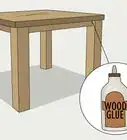This article was co-authored by Claudia & Angelo Zimmermann. Claudia and Angelo Zimmermann are the founders of Everneat, an Eco-Friendly Cleaning Service based in New York City and in Connecticut. They are also the founders of Clean Code, a DIY 100% natural cleaning product line.
This article has been viewed 8,230 times.
Oak dining tables are an excellent addition to any home, and can give your dining area a classy, rustic look. Oak is a temperamental wood type, however, so your table needs proper treatment and care to look its best. Fortunately, this isn’t too hard. With some waxing, regular cleaning, and proper positioning, your oak table should continue looking sharp for years to come.
Steps
Waxing the Table
-
1Wax the table as soon as you receive it. Treating your table with wax right away helps it acclimate to the climate in your home. As soon as you bring your table home, get ready to wax it.[1]
- It’s best to wax the table in the area that you’ll be keeping it, rather than outside or in the garage. The climate in those spots is different from the climate in your home.
-
2Set up a drop cloth or sheet around the table. Waxing isn’t a very messy job, but some wax pellets could still end up on your floor. Lay out a cloth or sheet underneath and around the table to prevent any messes.[2]
- It’s best to wear old clothes too, just in case you get any wax on yourself.
Advertisement -
3Get a standard wood wax designed for oak. There are many types and brands of wax that you could use. Professionals recommend beeswax products because they give the best finish. Any type will work, so check your local hardware store for oak wax and get a can.[3]
- You also have a choice between plain and colored wax. If you want to alter the color of your table a bit, then you can choose a colored type.
- If you’re unsure of which type to use, ask the manufacturer of your table what they recommend. You can usually find their contact information on the table packaging, their website, or from the store that you bought the table.
-
4Dust the table before applying the wax. Any dust or dirt will get trapped under the wax and could alter the finish. Take a clean microfiber cloth and run it over the entire table to get rid of any dust before you start.[4]
- The table also has to be dry before waxing, so don’t use a wet cloth to dust.
-
5Rub the wax all over the table along the grain of the wood. Take a soft, clean cloth and rub some wax onto it. Then spread the wax over every part of the table, moving along with the grain of the wood. You don’t have to worry about using too much or spreading it perfectly even. The important part is covering the whole table. Add more wax to the cloth as needed.[5]
- Don’t forget the edges and corners of the table as well.
- Moving with the grain is important to prevent air pockets and streaking.
- If you’re using a colored wax, then it’s best to apply it to a small area underneath the table first. That way, you can make sure you like the color before covering your table with it.
-
6Let the wax sit on the table for 5 minutes to soak in. When you’re satisfied that you’ve covered the whole table, then let the wax rest on the wood for 5 minutes. This short rest lets the wax penetrate into the wood for optimal protection.[6]
-
7Buff the wax off with a new, clean rag. Take a different rag from the one that you used to apply the wax. Rub firmly, again along the grain of the wood, to buff off any excess wax on the table. Continue until the table surface is smooth and uniform, with no leftover wax.[7]
- Buffing against the grain of the wood can cause streaking, so be sure to stick with the grain.
-
8Re-wax the table every 3-6 months. Wax could rub off over time, so keeping your oak table in top shape requires regular re-waxing. Professionals recommend waxing the table again every 3-6 months for the best appearance, so follow the same steps when you’re ready to re-wax.[8]
Keeping the Table Clean
-
1Dust the table weekly with a microfiber cloth. Oak is porous, and dust could get into small holes on the table surface. Use a clean microfiber cloth and wipe the table gently to remove dust. Repeat this at least once a week to prevent dust from building up.[9]
- If you’re having trouble picking up all the dust, try wetting the cloth before wiping the table.
- Don’t use any cleaning products, even if they’re designed for wood. Oak could stain if you use any chemicals.
-
2Blot spills with a damp rag. Spills happen, especially on a dinner table. It’s very important to wipe up spills as soon as they happen so the oak doesn’t absorb them. Wet a microfiber cloth and blot the spill until it’s gone.[10]
- You could use a bit of dish soap to help pick up spills. Just be sure to wipe up all the suds and dry the spot well when you’re done.[11]
- If the table has any set-in stains, it’s best to call a professional wood cleaner. Home remedies could ruin the wood.
-
3Use coasters and placemats to prevent stains on the table. Preventing spills and stains in the first place is the best policy. Always use coasters and placemats when you’re eating on the table. This prevents annoying stains from cups or dishes.
Positioning the Table
-
1Set up the table out of direct sunlight to preserve the color. Direct sunlight could fade the wood’s color over time. When picking a spot, make sure you position the table so it isn’t in sunlight at any point during the day.
- You could also use drapes or shades to block the sun during the day.
-
2Place the table away from vents. Heating or cooling vents could dehydrate the wood and cause the joints to separate. Position the table so it isn’t directly in the path of any vents in your home.
- Dramatic humidity changes can also warp the wood over time. Use your AC or a de-humidifier to keep your home’s humidity around 40-50%, which is ideal for oak.
-
3Leave space between the table and any walls for proper airflow. Placing the table right up against a wall leads to an inconsistent temperature and airflow over the table. Pull it away from walls and leave at least 25 mm (0.98 in) between the table and any other objects.[12]
Expert Q&A
-
QuestionHow do I protect my natural oak table?
 Claudia & Angelo ZimmermannClaudia and Angelo Zimmermann are the founders of Everneat, an Eco-Friendly Cleaning Service based in New York City and in Connecticut. They are also the founders of Clean Code, a DIY 100% natural cleaning product line.
Claudia & Angelo ZimmermannClaudia and Angelo Zimmermann are the founders of Everneat, an Eco-Friendly Cleaning Service based in New York City and in Connecticut. They are also the founders of Clean Code, a DIY 100% natural cleaning product line.
House Cleaning Professionals Always check the manufacturer's instructions first—they all have different guidelines. Some tables are sealed, while some aren't.
Always check the manufacturer's instructions first—they all have different guidelines. Some tables are sealed, while some aren't.
Things You’ll Need
Waxing the Table
- Oak wax
- Clean microfiber cloths
- Sheet or drop cloth
Keeping the Table Clean
- Microfiber cloth
- Coasters and placemats
Warnings
- Don’t place oak furniture outside unless it’s designed for outdoor use.⧼thumbs_response⧽
Expert Interview
Thanks for reading our article! If you'd like to learn more about treating oak, check out our in-depth interview with Claudia & Angelo Zimmermann.
References
- ↑ https://www.housebeautiful.com/uk/decorate/advice/a752/how-to-take-care-of-oak-furniture/
- ↑ https://youtu.be/UbQebXu3Te0?t=70
- ↑ https://www.housebeautiful.com/uk/decorate/advice/a752/how-to-take-care-of-oak-furniture/
- ↑ https://youtu.be/UbQebXu3Te0?t=37
- ↑ https://youtu.be/UbQebXu3Te0?t=42
- ↑ https://www.housebeautiful.com/uk/decorate/advice/a752/how-to-take-care-of-oak-furniture/
- ↑ https://www.housebeautiful.com/uk/decorate/advice/a752/how-to-take-care-of-oak-furniture/
- ↑ https://www.housebeautiful.com/uk/decorate/advice/a752/how-to-take-care-of-oak-furniture/
- ↑ https://www.thekitchn.com/how-to-maintain-a-wooden-dining-table-165534









































































